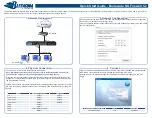
SECTION 3. RADIOTELEMETRY NETWORK COMPONENTS
3-3
Packet are routed from the computer to the
dataloggers on demand. These maintenance
type operations include the following:
•
Clock set or check.
•
Datalogger program download.
•
Get table definitions (query the datalogger to
see what data it has).
•
Data advise notification (start, stop, or
modify a data collection session with
datalogger).
If the RFBase is busy when in receives one of
these packets it will hold it until it is free. The
RFBase will only hold one of these operations in
its queue. These “transactions” conclude when
the datalogger returns a valid result code.
Packets generated by the dataloggers (other
than response codes to computer initiated
maintenance commands) are not routed on
demand, rather the datalogger is periodically
checked for any computer bound packets. The
user-specified Polling Interval determines how
often the dataloggers are checked. These type
of packets include data and any status, warning
or fault messages the datalogger generates.
The RFBase provides this polling independently
of the computer.
3.1.5.1 Areas
The RFBase is given a description of the
network along with the polling interval. For
maintenance type transactions, the RFBase
routes packet directly to and from the
datalogger using the user specified repeaters if
any. For polling, the RFBase divides the RF
network into areas. An area consists of one or
more remote RF95T and dataloggers sites that
are accessed by the same communication path.
If the number of remotes in a given area
exceeds 40, then that area is broken into
smaller areas. For example, if a network had
five remotes all accessed directly from the
RFBase then it would contain one area. If all
five remote were accesses through a common
repeater then there would still be one area. If
three of the remotes were accessed directly and
two were accessed through a common repeater
there would be two areas. The RF network is
polled one area at a time.
3.1.6 RF95T MODEM COMMUNICATION
PROTOCOL
Polling begins with the RFBase (or last common
repeater) sending a single short broadcast to all
remotes in the affected area. Each remote RF95T
upon receiving the broadcast checks the local
datalogger for any computer bound packets by
raising the dataloggers ring line and enter tele-
communications. The remote RF95T buffers any
packets it receives and exits telecommunications
with the datalogger. The remote RF95T modems
will then send the packets to the RFBase or
repeater that issued the broadcast. Each remote
RF95T responds during a predetermined time
window so the remotes do not conflict with each
other. In the network example with five remotes,
all accessed directly by the RFBase the sequence
would be as follows: broadcast by base, response
from first remote, response from second remote,
and so on until all five have responded. The
response windows are assigned by the base. If a
remote has more data then it can send during its
response window it responds with a special packet
indicating it has too much data. The base (or
broadcasting repeater) will then accessed this
remote after the poll and collect its data directly.
The RFBase holds all data it receives until it is
checked for packets by the computer. A
broadcasting repeater will return to the packets it
received to the RFBase after the repeater finishes
polling its area.
3.1.6.1 Retries on polling
If a polled remote RF95T fails to respond to the
broadcast, the RFBase or broadcasting
repeater will attempt 3 retries at the end of each
poll for all sites that did not respond. A
“Broadcast failure” messages will also be sent
to the computer. These retries take 2 to 3
seconds per site. If the retries also fail, a
“Polling Failure” message is also sent. These
retries take place after each polling cycle of the
affected area. Normally a remote will fail to
respond only if it is unable to receive or transmit
due to a hardware or power supply problem.
These retries may affect the polling of the
network when the polling interval is close to the
actual time required to poll the network.
3.1.7 RETRIES ON DIRECT MAINTENANCE
TRANSACTIONS
If a remote RF95T fails to respond to a direct
maintenance transaction, retries will be attempted
for approximately one minute. If the remote does
















































